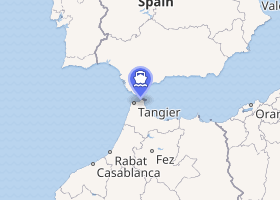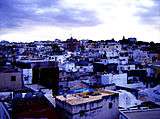Tanger-Med
The Port of Tanger Med (also written as Port of Tangier Med; Arabic: ميناء طنجة المتوسط) is a Moroccan cargo port located on the Strait of Gibraltar about 40 km east of Tangier, Morocco. It is the largest port on the Mediterranean and in Africa by capacity and went into service in July 2007.[2] Its initial capacity was 3.5 million shipping containers.[3] As of 2019, the port has been upgraded to handle over 9 million containers[4] and ranked the 18th in the world.
| Port of Tangier Med | |
|---|---|
Aerial view of the port | |

| |
| Location | |
| Country | Morocco |
| Coordinates | 35.874980°N 5.520710°W |
| UN/LOCODE | MAPTM[1] |
| Details | |
| Operated by | Tanger Med Port Authority S.A. |
| General Manager | Mehdi Tazi Riffi |
| Statistics | |
| Website www.tmpa.ma | |
Overview
The Tanger Med Project is the largest port in Africa. The project is a strategic priority of the Moroccan government for the economic and social development of the North Morocco region. It is part of the economic policy orienting Morocco towards exports, based on eight clearly identified export sectors, with particular emphasis on the free trade agreement with the European Union to be implemented by 2012.

Completion of the «Tangier-Mediterranean» project will have important economic effects in terms of jobs, creation of added value and foreign investment. Its particular position on the Straits of Gibraltar, at the crossing of two major maritime routes, and 15 km from the European Union will enable it to serve a market of hundreds of millions of consumers through the industrial and commercial free zones which will be run by well-known private operators. It will also win part of the strong growth market of container transshipment and become the leading hub for cereal transshipment, a facility which is non-existent in the north-west African region at present.
The project will be implemented, coordinated and managed by TMSA, a private company with public prerogatives, operating under an agreement with the State and interacting with the different ministries involved.
The port complex will have important economic effects in terms of jobs, creation of added value and foreign investment. In addition to the economic effects of the operation of the port, there will be important effects resulting from its construction, particularly through foreign investments, and others from the operation of the free zones (direct and indirect added value, direct gains, jobs and foreign investment).
A draft loan contract of $180 mln to fund the expansion works of Tanger-Med port was signed in October 2008 for building a second deepwater port, dubbed "Tangier Med II", to meet the growing demand for container handling at international level in sea transport. The new port facilities, scheduled to be operational by the second half of 2012, will include two new container terminals with a total length of 2,800 m and an additional nominal capacity of 5 million containers.[5] Final official approval for "Tangier Med II" was received on 7 January 2009, with actual construction started on 17 June 2009.[6][7] In November 2010 the European Investment Bank (EIB) signed a loan of €200 million for the extension of the port.[8]
The port is expected to reach full capacity by 2015, and to operate 8 million containers, 7 million passengers, 700,000 trucks, 2 million vehicles, and 10 million MT of oil products.[9] When completed in 2018, it is expected to be the busiest port on the Mediterranean.[10]
Port Capacity
Tanger Med Port
- total of 9 million containers of capacity
-Tanger Med I Port
- 3.5 million containers of capacity
- 1.6 km of container docks at -16 and -18 meters
- 2.6 km of dikes
- 140 hectares of land, of which 80 hectares for container traffic, served by rail
- 2 petrol stations
- 0.6 km from quai vraquier
-Tanger Med Port Passengers
- 2.5 km from dikes
- 8 berths with draft of 9 and 12 meters
- 35 hectares of land reserved for passenger and TIR activities
- Several supporting spaces representing a total of 30 hectares of median
-Tanger Med II Port
- 5.5 million containers of capacity
- 2.8 km of container docks at - 16 and - 18 meters
- 4.8 km from dikes
- 160 hectares of land totally won over the sea
- 2 optional oil stations
Industrial platform
More than 750 companies operate in this platform. Among the companies that operate out of Tanger are:
- Bosch
- Daher
- Huawei
- 3M
- Decathlon
- Emirates Logistics Group (has teamed up with Adidas AG)
- Furukawa Electric
- Siemens
These companies represent a yearly export turnover in excess of €5,500 M in various sectors such as automotive, aeronautics, logistics, textile and trade. In 2017, Tanger Med hosted 54 new industrial projects.
Automotive ecosystem at Tanger Med
Renault TangerMed hosts the largest car plant in Africa.
Tanger is home to the following automative companies:
- Renault Nissan
- Fiat
- Delphi Auto
- Hands Corporation
- Sogefi
- Denso
- Magnetti
- Yazaki
- Valeo
See also
- Economy of Tangier
- List of deep water ports
- Port of Algeciras
References
- "UNLOCODE (MA) - MOROCCO". service.unece.org. UNECE.
- Tanger Med Port Authority
- "Tangier-Med port to be operational in July" Magharebia
- http://www.tmpa.ma/en/activites-services/activite-conteneurs/
- "AFESD approves loan", Maghreb Arabe Presse
- Staff (7 January 2009) "King launches construction works of Tanger-Med industrial park" Maghreb Arabe Presse
- Staff (18 June 2009) "Tanger Med expansion: King launches construction works" Morocco Business News
- "EIB signs €420 million in loans for Moroccan highways and port" Archived 2011-07-16 at the Wayback Machine ENPI Info Centre
- "Maghreb Arabe Presse: Import-export activities kick off in Tanger-Med port, TMSA". Archived from the original on April 9, 2008. Retrieved June 3, 2008.CS1 maint: BOT: original-url status unknown (link)
- "Morocco is doing well, but its king still needs to adapt". The Economist. 11 June 2016. Retrieved 11 June 2016.
External links
| Wikimedia Commons has media related to Tanger Med. |
